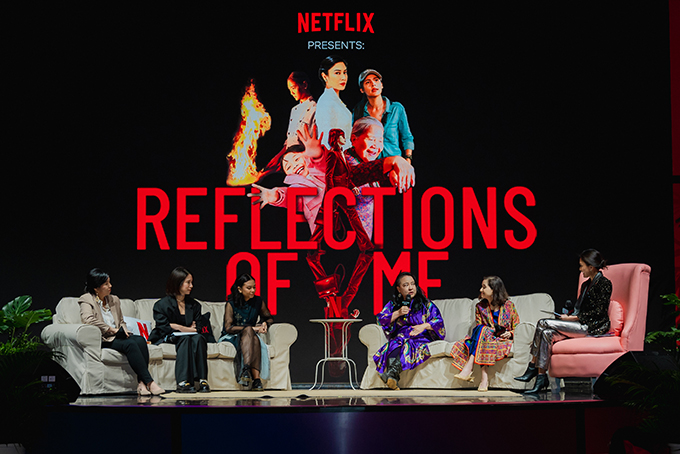“I want to show Vietnam in a way that is not about the war. Pretty much every American movie about Vietnam is about the war—but the country is so much more than that. In A Tourist’s Guide to Love, I wanted to showcase the place, the people and the culture in a fun and celebratory way,” says Eirene Tran Donohue, a Vietnamese-Irish screenwriter and the brain behind A Tourist’s Guide to Love, a sweet rom-com set in Vietnam launching on Netflix in April this year.
Tran Donohue is in Jakarta for Netflix’s landmark International Women’s Month event, joined by a host of women from the various facets of the film industry around the region—from Indian film critic Anupama Chopra to Indonesian filmmaker Kamila Andini. Entitled Reflections of Me, the panel event has been designed to unpack a mission many attendees share: representing authentic female characters in film and television.
In the context of Southeast Asian film—which, while still developing, is doing so at an incredible rate—the name of the panel rings particularly true. Historically, the stories of Asian women (and specifically, Southeast Asian women) have rarely been told on screen. Thanks to filmmakers like Andini, this is finally changing.
“My work is always personal. In a way, I direct my own stories,” says Andini. “So there’s always a female character in the lead—she could be a young girl, a teenager, a mother. These characters have a lot of me in them. My hope is that they also reflect the women around me, and they represent the things we all feel and go through.”

Asian women have, for a long time, been kept out of the lead roles in big projects, or denied the top seats in a filmmaking team. You might be good enough to play the geeky best friend or an exotic femme fatale, but serious roles were often reserved for other actors.
For Filipino director Marla Archeta, being told by her producer that the protagonist in her first film, Finding Agnes, had to be male, meant that she had to find other ways to represent women in her story. “It was a given that the lead would be a man. But what we did was inject key women figures who would influence him. So at the end of the film, you realise that it’s not just about the protagonist’s journey, but it’s also about all the women around him who played important roles.”
“If you watched a film or series with an Asian female character, you’d see either a conservative mother or a daughter who tries to rebel against her family”
“The ’80s, when I was growing up, were considered the worst years of Hindi cinema,” laughs Anupama Chopra, a leading film critic and head of Netflix’s Take Ten programme in India—a film workshop and competition sponsored by the Netflix Fund for Creative Equity that aims to discover and support emerging filmmakers from diverse backgrounds in India. Through the programme, ten filmmakers are given the opportunity to attend workshops by the best in the creative industry, and then to make a fully funded short film. The films, when complete, are shown on Netflix’s India YouTube channel.
“The films I had access to back then were super simplistic, not layered, and you barely saw women who weren’t just props for men. The leading ladies would just be there to sing and dance, like an accessory. But there was one film released in 1987—Mirch Masala—that was incredible. It was a story set in pre-independence India, about a village woman who pushes back against the sexual advances of a very powerful tax collector.”

“It’s just the most profound film with Smita Patil, who was this great actor,” Chopra elaborates. “The women all work in a spice factory, which is where the film gets its name. In the end, they come together and throw red chilli powder into this man’s face to protect this woman whom he was pursuing. And I’ll never forget this frame—Smita is just standing there with a sickle in her hand. Just one film can make that level of impact.”
For Tran Donohue, who grew up in the US, what she truly missed in her younger years was strong Asian female representation on television. “There were hardly any Asian faces in the movies at the time. When the Joy Luck Club came out, it was amazing to see Asian women, and those family and community storylines. It was a powerful experience for me,” she says.
“That was my first encounter seeing women who looked like me represented in Hollywood too,” Indonesian actress and journalist Marissa Anita, who moderated the session, agrees. “This year, we have an amazing achievement by nearly a fully Asian team at the Oscars, with Everything Everywhere All at Once. So things are looking up.”
“The great thing now is that the types of roles available for Asian women have greatly expanded,” says Thai actress, director, producer and writer Manatsanun ‘Donut’ Phanlerdwongsakul, who plays the role of a park ranger vital to the rescue mission in Thai Cave Rescue. “Back in the day, if you watched a film or series with an Asian female character, you’d see either a conservative mother or a daughter who tries to rebel against her family and has problems with her culture. But more doors have opened for us now.”
“The script is really important,” Phanlerdwongsakul adds. “We need more scripts like Everything Everywhere All at Once, or Parasite, or Thai Cave Rescue. It gives us a chance to play different sorts of roles—all of which we belong in.”
Watch the full panel in English, Bahasa Indonesia, Vietnamese and Thai on Netflix Asia’s YouTube channel.





